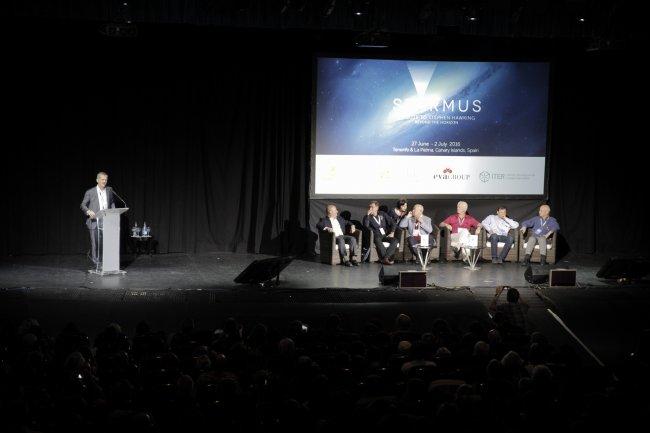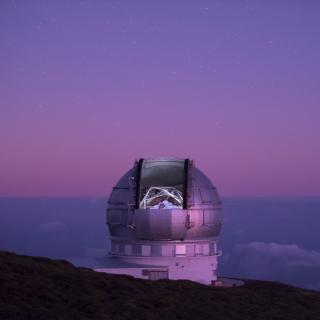The sessions of the second day of the Starmus festival, moderated by the astrophysicist Jill Tarter, Director of the SETI project, began with a talk by the Nobel Laureate for 2011 in Physics, Brian Schmidt who, together with Adam Reiss and Saul Perlmutter, discovered that the universe is in a state of accelerating expansion. Schmidt, for whom “the power of astronomy is that it lets us look directly into the past”, talked about the “dark” dark universe, referring to the dark matter (26%) and the dark energy (69%) of the universe. In his talk, he explained how he arrived at the conclusion that the universe is accelerating in its expansion by observing tens of explosions of supernovae type Ia in distant galaxies. He said that at first they didn’t believe their own data and spent months checking it out. Only when they saw the data of Perlmutter’s group were their doubts removed. Ha added that we don’t know just what dark energy is, but it is clearly everywhere.
After that the mathematician Roger Penrose received the applause of the audience when he brought out his plastic transparencies and said: “I'm sorry, but I use old technology”. He also caused a surprise when he said that he did not believe in inflation. His hypothesis “Cyclical Conformal Cosmology”, which was published some years ago, proposes that the universe did, shortly after the Big Bang, have a period of accelerated expansion, but that this was just one of many which have occurred since before the Big Bang throughout the course of the eons. If his theory is correct, he said, we should be able to detect specific circular patterns in the microwave background radiation. He explained in a diagram on his transparency the observational consequence of the variations in the relation between temperature and density in the microwave background. As a mathematician he used geometry to visualize these periods of inflation, and how to connect one period with another.
Chris Rapley, an expert in climate change, began by saying that the agreement reached in the recent Paris summit about this was good news, “although many people think that it would be better to keep global warming below 1.5 degrees”. This scientist, who has carried out research deep into the Antarctic ice going back to 850,000 years ago, to measure that natural variation of the CO2 content of the atmosphere, said that in the past decades the increase has been far more rapid than that due to natural variation, that sea level is rising by 30 cm per century now, and that if he were from an extraterrestrial civilization the rapid rise in sea level and in atmospheric CO2 would tell him that something interesting was going on here. “The Arctic is changing dramatically” he said, “and people’s lives there are greatly affected. I am sure that we have the capacity to supply humanity with clean energy, because human ingenuity is unlimited”. He also said that it is important to build bridges between scientists, society, and the decision makers. “Science should not say what is good and what is bad, it should inform society, and say that a rise in temperature of more than two degrees would have very negative consequences”. He put the question “Do we care about the poor, and about future generations?” to which he answered “It’s a matter of deciding in what type of world we want to live, what type of future we want to create”.
Jill Tarter and the physicist and popularizer Neil DeGrasse Tyson then had a discussion about intelligent life in the universe. Tyson commented that “Maybe for us to survive in the face of an extraterrestrial civilization, it would be best if they don’t suspect that there is intelligent life here”. He also said that “It will always be easier to resolve our problems here that to terraform Mars and send 4,000 million people there. We should go to other planets and cosmic destinations as tourists, not to survive”. Tyson suggested that if we take the assumption that we are the only intelligent species here on Earth, the only one which builds spaceships, compared with how many species there have been over a given length of time, this will give us an estimate of the frequency with which intelligence appears (rather low). They also talked about the relation between the emergency of intelligence and natural catastrophes such as the impact of a meteorite. Basically Tarter thought that intelligence must be a common feature in the Universe, while Tyson thought that it not likely to be so common, and added in humorous tone that “Maybe we are the pets of an intelligent species who has put us in a zoo where we can be happy”. He then said that “Machines will continue to serve us, and I am not at all afraid of them, because even though they can now beat us at chess, this does not mark the end of civilization”. For Tyson, young people of around 20 years old are not “the digital generation” but “the exoplanet generation” born after the discovery of the first exoplanet in 1995, in the Internet era, and this is why they know that science and technology are important for their future.
The Russian cybersecurity expert Eugene Kaspersky commented that informatic attacks are continually on the increase. “If only the economy would grow at a similar rate!” he added. He added that scientists tend not to pay much attention to informatic security. “What is the cost of cybercrime to the global economy? We don’t really know, but there are estimates in the range between 400,000 to 500,000 million dollars per year”. He also told us about the “business model” of the new digital criminals, who concentrate on the transport and manufacturing sectors. He gave the example of hackers who infiltrate the informatic systems of the customs departments in order to facilitate drug trafficking. During his talk he mentioned the Russian GAGARIN telescope project, of 60m diameter, which, according to the Rector of Moscow University, would be built in the Canaries.
After a show by the comic and conjurer David Zambuka, with the collaboration of the physicist and popularizer Brian Cox, we hear from Edvard Moser, who together with his wife May-Britt Moser received the Nobel Prize in Medicine 2014 for discovering what has been called the “GPS of the brain”. He commented that one of the greatest recent achievements of neuroscience is bringing together psychology and physiology; one example of this is the study of how the brain “knows” how to orient itself in space. Moser explained the origin of the concept of a spatial map in the brain, a concept which has been steadily refined since the 1950’s and 60’s, “For example”, he explained, “in the 60’s it was found that there is a zone in the brain, the hippocampus, where there are neurons which give information about spatial position, which were called “place cells””. At the end of the 70’s these were shown to be key to spatial mapping. Moser started to work in this area later on, studying how the neurons build up a system of coordinates which allow the brain to orient itself, a sort of precise map, a system which maps space at high resolution within the brain.
For the engineer and mathematician Danny Hillis the frontier between the natural and the artificial is getting increasingly blurred. He spoke about learning to grow artificial organs, about understanding the code with which the brain stores information, and to then create mental prostheses. “We tend increasingly to design objects such as chips and even pieces of cars, following a process inspired by the evolution of biological organisms. We are changing ourselves and our environment by mixing what is natural with what is artificial. This is seen in aesthetics as well as in music “(he has composed computer generated music). “ We are beginning to live in a jungle created by ourselves in which the natural and artificial worlds are superposed. This is very complex, and we need to adapt to it. We need to redesign ourselves so as not to be the bosses of nature, but to collaborate with her”.
Carolyn Porco, an expert on the Solar System, talked about Saturn, She reminded us that within two days we will be celebrating 12 years of the Cassini mission, in orbit around Saturn, She stressed that Cassini, which will be ending in September, has been one of the most successful scientific missions. She mentioned some of its highlights, such as the spectacular hurricane near Saturn’s North Pole which covers an area equivalent to half the area of the United States. The rings of Saturn, which are extremely thin, are composed of particles of ice of different sizes extending radially over 280,000 km. “We have seen amazing things which surprised us” she said “for example when the particles in the rings are compressed and generate mountains of residuals at the edges of the rings”. Exploring Titan was also one of the objectives, and we should not forget the European Huygens probe which landed on this, the biggest of Saturn’s satellites. Huygens found a chain of lakes in the northern part of Titan, lakes of liquid organic compounds. Finally she explained how she had planned, in 2013, that Cassini would take a photograph of the Earth from Saturn, as Carl Sagan had done previously with ´Voyager from beyond the orbit of Neptune. Using the web she had encouraged the public all over the world to smile at the camera at the correct moment, while Cassini took the photo.
The final item in the session was a panel discussion about the future of space exploration. Among the astronauts who took part (Leonov, Schweickart, Nicollier, Romanenkho, Volkov, Reisman y Hadfield) they had performed 14 space walks. Each gave a personal view of their space experience. For the cosmonaut Alexei Leonov his Starmus festival is unique in bringing together so many special people. He remembered Neil Armstrong, who gave his final public lecture at the first Starmus. “The most important event of the past millennium was certain the achievement of Neil Armostrong. But today we cannot travel to the Moon or Mars without an international agreement”, he said. For Roman Romanenkho the most beautiful thing he saw from space was our own planet, “from there you cannot detect frontiers” he added, to the applause of the audience. Finally Garrett Reisman presented a film showing how the SpaceX project has succeeded in recovering the booster rockets from its recent space missions using a soft landing technique, which could usher in the age of economic spaceflight.
Related press releases:



